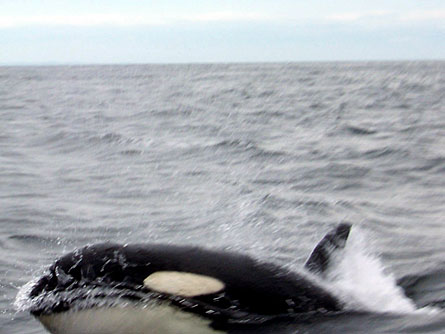How killer whales are like people
At a green-chemistry conference at the University of Maryland, last Thursday, filmmaker/diver/marine explorer Jean-Michel Cousteau described the back story for his latest documentary: Call of the Killer Whale. He and his crew were interviewing scientists who study these top predators — the most widely distributed marine mammal on the planet — when they learned that this species is also heavily contaminated with certain toxic industrial contaminants. Indeed, Cousteau learned, these orcas appear to hold record levels of some pollutants.


People eat many of the same foods that orcas do (think salmon). We also dine upon some of the same foods eaten by harbor seals and others of the orcas’ bigger prey species. If diet is a major source of the polychlorinated biphenyls (electrical insulators) and polybrominated diphenyl ethers (flame retardants) showing up in whales and other marine mammals, Cousteau’s team got to wondering how polluted people might be. And whether diet might explain individual variations in concentrations.
So several people agreed to share data from tests measuring blood levels of these compounds: Cousteau; his assistant producer on the film, marine biologist Holly Lohuis; her four-year old son Gavin; and team still photographer, Carrie Vonderhaar. Cousteau and Vonderhaar are both omnivores, Lohuis and her son vegetarians.
The bottom line, as outlined in Cousteau’s new film: People indeed carry residues of the same toxic compounds that are found in killer whales. However, diet apparently doesn’t always explain the differences in human accumulations of these chemicals. Especially the flame retardants.
For instance, while Cousteau and Vonderhaar had body burdens of around 20 nanograms of PBDEs per gram of fat, Lohuis had 200 — and her son 800 ng/g. On film, a tearful Lohuis expressed her concerns over the toxic substances to which we, as a society, are inadvertently exposing our next generation, like Gavin.
At last week’s talk, Cousteau offered a followup on the boy’s contamination. Because Lohuis and her son share a similar diet, it appeared sources other than food were contributing to Gavin’s extremely high PBDE values. Holly reasoned that her preschooler’s exposures might trace to furniture and carpeting, both of which are commonly treated with flame-retardant chemicals, especially in their home state of California. Moreover, young children tend to spend a lot of time on floors, where PBDE-laden dust residues might be expected to collect.
So after filming for the orca project wrapped up, Lohuis ditched her carpets and replaced her old sofa with one that hadn’t been treated with PBDEs. As of last week, Cousteau reported, Gavin’s blood residues of flame retardants were receding, albeit slowly .
“Orcas are to the ocean what we are to the land,” Cousteau said — long-lived top predators that collect and accumulate what is in our environments. An orca biologist interviewed for the film noted that in one heavily contaminated pod he’s been studying, adults seem to be faring well. Not so their youngsters. Baby orcas in this family survive a few years while nursing, only to disappear — and presumably die — shortly after weaning.
What observational and environmental toxicology studies on whales are showing, Cousteau argues, is that “We can’t afford to kill off the whales through the toxi[cant]s” — because “we’re next.”
I certainly hope his concerns prove hyperbole. But we must not continue to take for granted that they are. It was a concern shared by many people in the audience, last week — scientists and engineers devoted to developing goods and processes that use and release fewer toxic substances.






